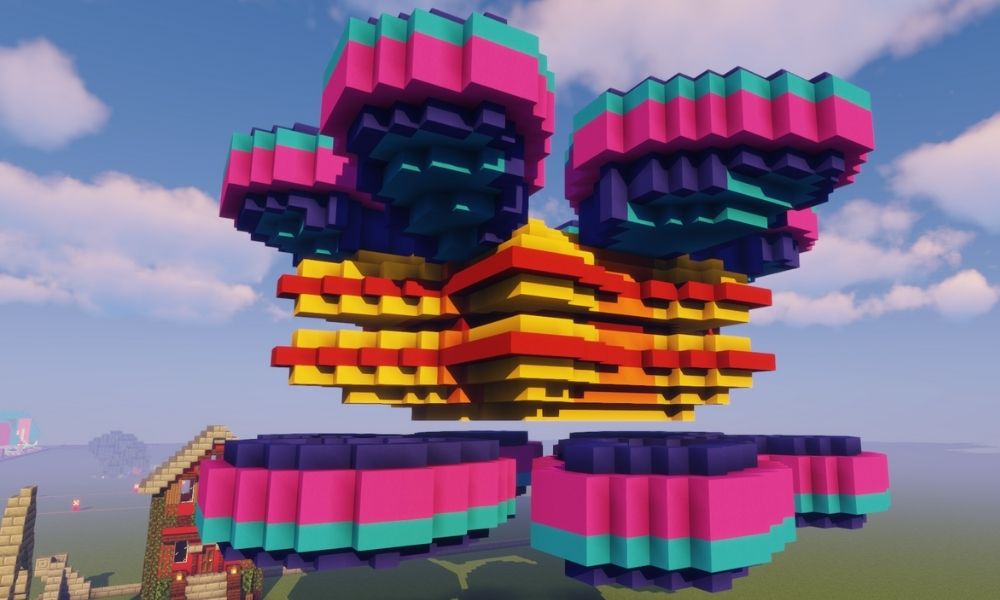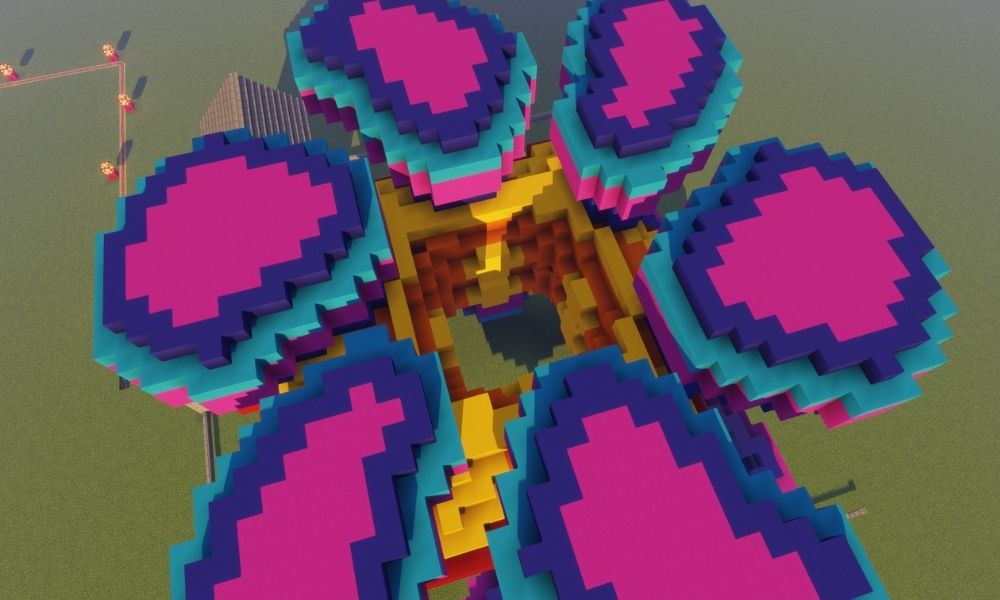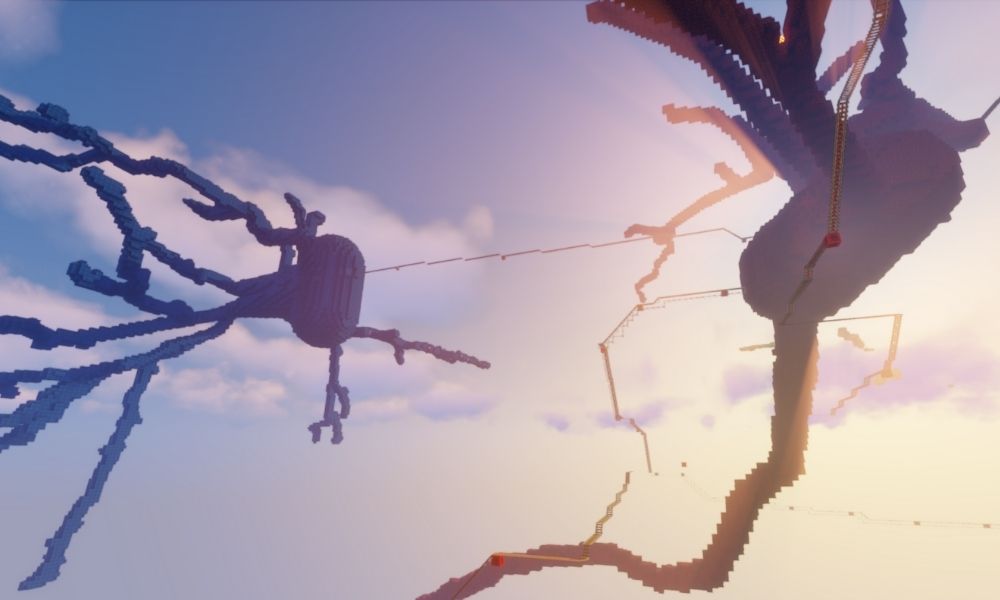
In this post, Richard Fitzpatrick a final year PhD student working in the Centre for Discovery Brain Sciences as part of the University of Edinburgh-Zhejiang University partnership, explains how the popular sandbox videogame Minecraft can be used for teaching and how it can lead to sustained engagement, enthusiasm, and creativity. There are links to videos from Richard’s Minecraft-based teaching projects at the end of the post…
I’ve spent the past year exploring if Minecraft is a useful tool to assist in teaching at a University level. To some, this might seem like the naïve whims of a PhD student. But I hope to convince you here that this idea is an enormously powerful way to inject creativity into subjects which are not normally associated with that term, that it goes much further than just being fun, and inspire you in doing this yourself in your own subject areas.
I must credit Philippa Sheail, Noreen Dunnett, and Stuart Nicol, who gave a talk in the 2018 Learning and Teaching Conference that explored their use of Minecraft within the Digital Education MSc programme. This act of seeing Minecraft being used in a University setting was a real “lightbulb” moment: could I possibly use this in my own teaching?
I received a PTAS grant in 2019 (along with my PhD supervisor, Dr Melanie Stefan) and used this to employ four Biomedical Sciences undergraduate students (Okuk Takon, Srivatsan Rajagopalan, Simon Parker and Connor Schlemmer) for one month. We set out to build two different models, independently but within the same game world. The first was constrained to a brief – the model had to help explain something about CaMKII, (a protein involved in memory formation). The team (including myself) had to research the molecule, assess what facet of its structure or function they wanted to build, how to do that, and build it. For the second model the students had a choice: continue to build the first model or do something entirely different.

The models constructed varied in size, scope, and success. Each model was distinct and highly inventive, and none were mere recreations of a textbook figure. This chance to be creative – to choose the direction of their research and work out how to disseminate their newfound knowledge – came through in follow-up reports as being the driving force behind their engagement, even when things did not go according to plan. They all took away a great deal of knowledge and understanding of the concepts that underpinned these attempts, maturely reflecting that the gain in understanding was not lessened by any failure in bringing those concepts into a working model.

This idea has since grown to encompass outreach and foster interdepartmental collaboration. Simon’s DNA Factory model inspired me to construct an activity for the Edinburgh and Glasgow Science Festivals, which is having great levels of interest online (www.neuronsafari.com). Simon has been working with myself and colleagues from the School of Engineering (EdAR) using Minecraft as a way for speeding up the construction and implementation of Augmented Reality models for Biology. I’ve also co-supervised an Honours Project student (Siobhan Vickerstaff), reproducing an epidemiological model within the game that can be readily adapted for use in the classroom and public engagement.
I should note that I lacked any Minecraft experience before starting this project. I did have plenty of passive knowledge of the game. I knew it was a bit like digital Lego. I knew people could construct incredibly complex and detailed machines and structures. I also knew that a good number of students would have played it – 126 million people play at least once a month. There was an opportunity to harness some of this student experience, which has proved successful and taken this idea much further than I had anticipated.

This approach has inspired me to think more creatively, to challenge how I engage with learners of different ages and taught me new skills. For the learners I have interacted with, there has been sustained engagement, enthusiasm, and creativity that makes me excited about where this idea could go. Mitchel Resnick from the MIT Media Lab suggests that we need creative thinkers, and therefore learning that exemplifies “Projects, Peers, Passion, and Play” – I believe this approach ticks all those boxes.
Using Minecraft in Hybrid Teaching Contexts
Minecraft also offers an environment that affords both synchronous and asynchronous learning and communication between students and educators. Multiplayer servers provide a space for up to 30 players simultaneously in the same in-game world. Students can communicate using the in-game chat feature, or leave notes in the forms of books and signposts for others to find at a later date. Users can also watch others play through a game world via live streaming, through familiar platforms such as Microsoft Teams, or to much larger audiences via platforms like Twitch or Youtube Gaming. This allows for collaboration in instances where users don’t have compatible devices or are away from their computer, for educators to teach and troubleshoot problems in real-time with users, and opens up additional avenues for live and interactive outreach with a global audience.
At the time of publication, I’m working on reworking ecological projects that would normally take place out in the field (well, beach in this case!) within Minecraft. Like in the field, students will learn about methods of data collection, how to sample an environment effectively etc., but through examples taught within the game world. More importantly, students still have the freedom to collect data in their own way within the world, at their own pace and in their homes. We are looking at how collaboration or streaming can play a role in this too, to make the experience truly hybrid, and to match more closely the experiences of real world fieldwork.
- https://www.youtube.com/watch?v=ev0Vl_KFxmU Siobhan’s Minecraft work
- https://www.youtube.com/watch?v=QOWiknnYFf4 Siobhan’s Minecraft work
- https://www.youtube.com/watch?v=OfkCSAgr35I Simon’s work
- https://www.youtube.com/watch?v=nAXU-Al7adI Neuron Safari Trailer

Richard Fitzpatrick
Richard is a final year PhD student (submitting in December!) working in the Centre for Discovery Brain Sciences as part of the University of Edinburgh-Zhejiang University partnership. His work is split between developing biochemical models of synaptic plasticity and models for use in different pedagogical settings. MinecraftEd is an ongoing aspect of the latter, and he is always looking for new collaborations to help implement both typical and atypical modelling environments into tertiary-level teaching.


Great to see where you have taken this Richard. Some amazing and inspiring work. Just shows that play and creativity isn’t just for kids!
Thanks Noreen! So grateful for all your helpful advice and inspiring this in the first place!